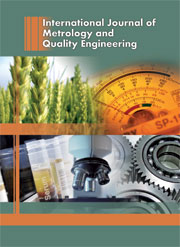Crossref Citations
This article has been cited by the following publications. This list is generated based on data provided by
Crossref.
Kok, G J P
Harris, P M
Smith, I M
and
Forbes, A B
2016.
Reference data sets for testing metrology software.
Metrologia,
Vol. 53,
Issue. 4,
p.
1091.
Linares, J.M.
Goch, G.
Forbes, A.
Sprauel, J.M.
Clément, A.
Haertig, F.
and
Gao, W.
2018.
Modelling and traceability for computationally-intensive precision engineering and metrology.
CIRP Annals,
Vol. 67,
Issue. 2,
p.
815.
Hutzschenreuter, Daniel
Härtig, Frank
and
Schmidt, Markus
2018.
An SQP method for Chebyshev and hole-pattern fitting with geometrical elements.
Journal of Sensors and Sensor Systems,
Vol. 7,
Issue. 1,
p.
57.
Arezki, Yassir
Zhang, Xiangchao
Mehdi-Souzani, Charyar
Anwer, Nabil
and
Nouira, Hichem
2018.
Investigation of minimum zone assessment methods for aspheric shapes.
Precision Engineering,
Vol. 52,
Issue. ,
p.
300.
Arezki, Yassir
Mehdi-Souzani, Charyar
Anwer, Nabil
and
Nouira, Hichem
2018.
Reference data simulation for L∞ fitting of aspheres.
Procedia CIRP,
Vol. 75,
Issue. ,
p.
331.
Papananias, Moschos
Obajemu, Olusayo
McLeay, Thomas E
Mahfouf, Mahdi
and
Kadirkamanathan, Visakan
2020.
Development of a New Machine Learning-based Informatics System for Product Health Monitoring.
Procedia CIRP,
Vol. 93,
Issue. ,
p.
473.
Catalucci, Sofia
Senin, Nicola
Sims-Waterhouse, Danny
Ziegelmeier, Stefan
Piano, Samanta
and
Leach, Richard
2020.
Measurement of complex freeform additively manufactured parts by structured light and photogrammetry.
Measurement,
Vol. 164,
Issue. ,
p.
108081.
Chiboub, Amine
Arezki, Yassir
Vissiere, Alain
Mehdi-Souzani, Charyar
Anwer, Nabil
Alzahrani, Bandar
Bouazizi, Mohamed Lamjed
and
Nouira, Hichem
2021.
Generation of Reference Softgauges for Minimum Zone Fitting Algorithms: Case of Aspherical and Freeform Surfaces.
Nanomaterials,
Vol. 11,
Issue. 12,
p.
3386.
Forbes, Alistair
2021.
Generation of numerical artefacts incorporating spatially correlated form error.
Measurement: Sensors,
Vol. 18,
Issue. ,
p.
100302.


